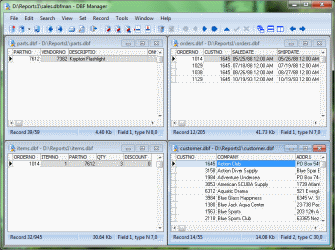

delivery date > order date).ĬOMPUTED BY ( UPPER(COL1 COLLATE PXW_CYRL) ) It is also possible to define table constraints in this way (e.g. the value in the PRICE field must be larger than 0 and smaller than 10,000. It is possible to define field constraints, e.g. It's a way to be able to associate values on the same row. Checks allows you to add a simple piece of logic so that every time you change that table, it's checked for validity. Checks: Further conditions can be specified by the user (check constraint).Please refer to Referential integrity and Cascading referential integrity for further information. When defining a foreign key relationship, it is necessary to specify what should happen to the foreign key, if the primary key is updated or deleted. Foreign keys: A foreign key is a link to another table and stores the primary key of another table.There is however a workaround in IBExpert, should you ever find yourself in the situation, where you need to add a primary keys to existing tables (please refer to Adding primary keys to existing tables). Primary keys: A primary key can officially only be defined at the time of defining a new table.The FK Table column (on the far right) displays the referenced table name if the field is a part of the foreign key. By double-clicking on the right edge of the column header, the column width can be adjusted to the ideal width. PK, FK, Field Name etc.) you wish to sort by. Tip: as with all IBExpert dialogs, the fields can be sorted into ascending or descending order simply by clicking on the column headers (i.e. Similarly a primary key cannot be specified following data entries with duplicate values.įields can be dragged 'n' dropped from the Database Explorer tree and SQL Assistant into the Table Editor's field list, allowing you to quickly and easily copy field definitions from one table to another. a field cannot be altered to NOT NULL, if data has already been entered which does not conform to the NOT NULL property (i.e. Please note that it is not always possible to alter certain fields once data has been entered, e.g. Fields can be amended by simply overwriting the existing specification where allowed. The individual columns are explained in detail under New Table. The many possible field specifications are listed on the Fields page. Items not represented in the toolbar include the deactivation and activation of all triggers or indices, Empty table and Drop table: The Table Editor menu includes a comprehensive list of actions, the majority of which are also available in the Table Editor toolbar. (A total of 255 changes may be made to a database object before Firebird/InterBase ® demands a backup and restore). Note: the IBExpert status bar shows how many remaining changes may be made to the table before a backup and restore is necessary. Alternatively check the Restore last active page when editor reopened option, if this is more practical. instead of the Fields page always visible when the Table Editor is opened, specify the Data page, if you need to do a lot of data manipulation). Use the IBExpert Options menu item, Object Editors Options, to specify which of the many Table Editor pages should be active, each time you open the Table Editor (e.g. The Table Editor comprises a number of pages, opened by clicking the corresponding tab heading, each displaying all properties which have already been specified, and allowing certain specifications to be added, altered or deleted.

It can be started directly from the DB Explorer by simply double-clicking on the relevant table in the IBExpert DB Explorer, or using the DB Explorer right-click menu Edit Table.

The Table Editor can be used to analyze existing tables and their specifications, or to add new fields, specifications etc, in fact, perform all sorts of table alterations.


 0 kommentar(er)
0 kommentar(er)
